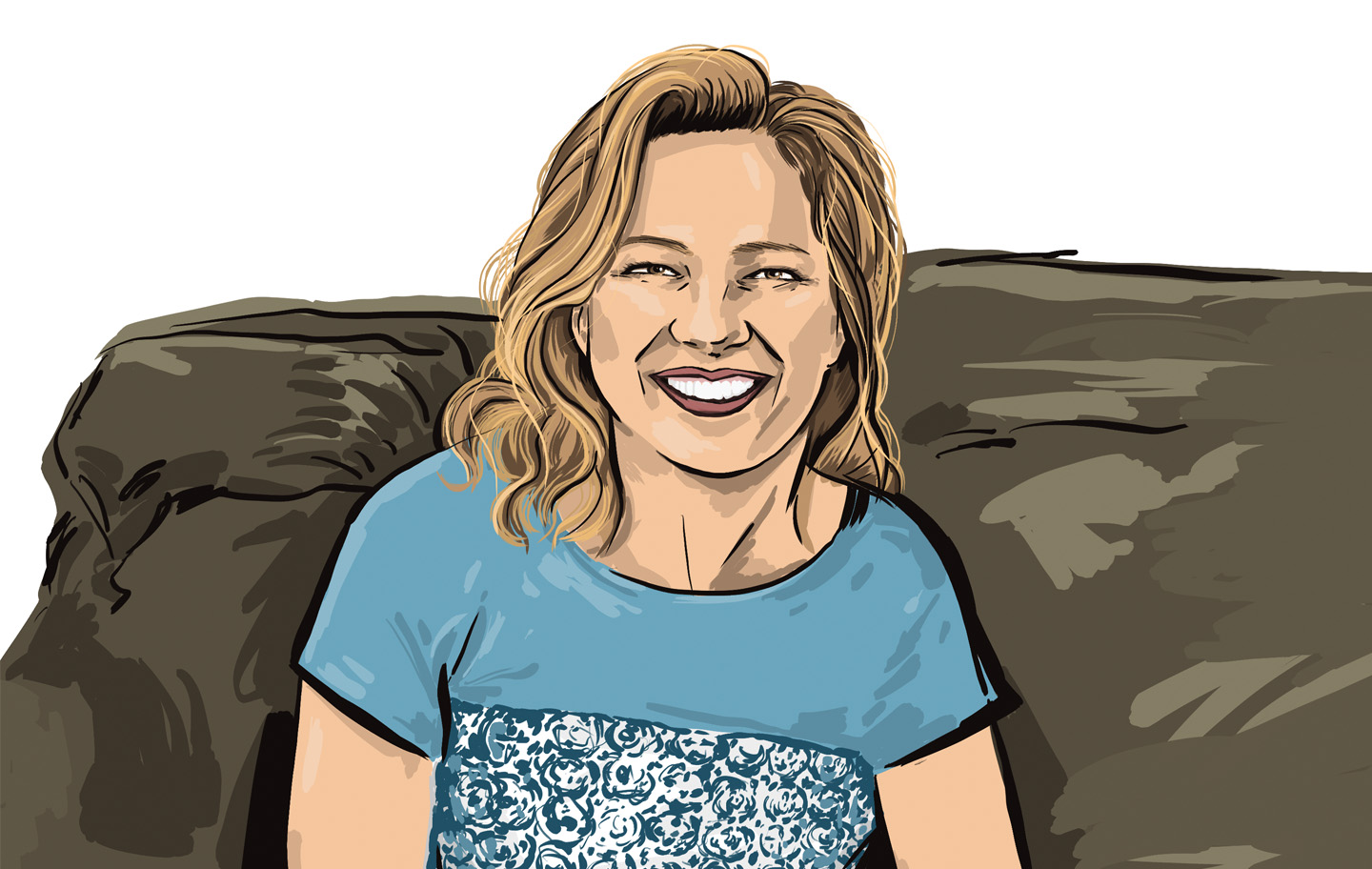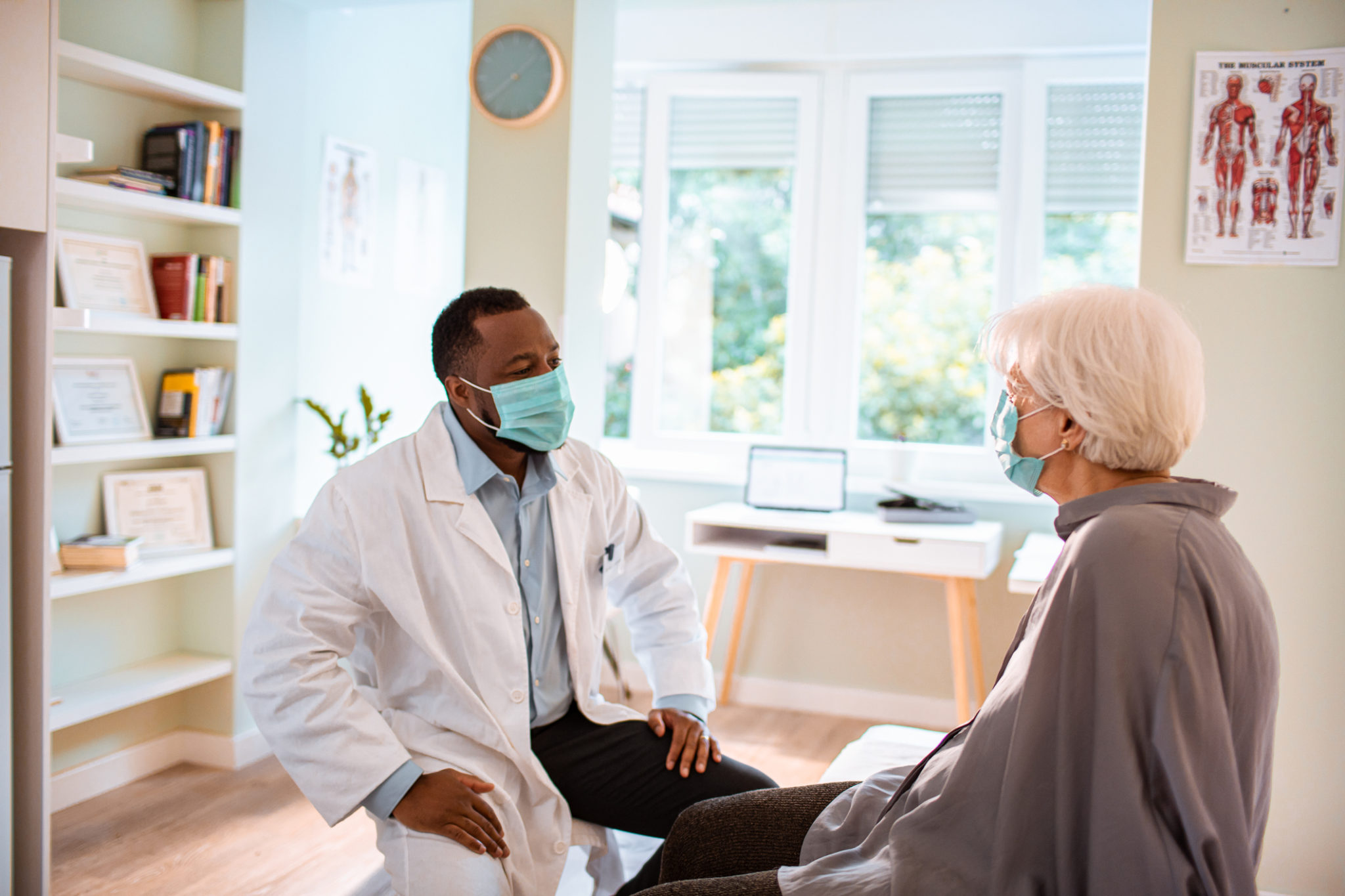Hazlet Breast Cancer Patient Chooses Groundbreaking Reconstructive Technique

April 11, 2021
Typically, we photograph every patient appearing in HealthU. Because this story was planned during the COVID-19 pandemic, that contact would have been too risky. Instead, our team took a creative approach and replaced photo shoots with illustrated portraits of patients.
Nancy Charpek of Hazlet, New Jersey, was in a good mood January 8, 2020, as she headed off to her appointment to learn the results of her latest mammogram. It had been 10 years since the 58-year-old mother of two adult children and new grandmother had finished treatment for her first breast cancer diagnosis—ductal carcinoma in situ (DCIS).
She was expecting good news, but it wasn’t to be.
Waiting Game
“Nancy came to the Women’s Center at Riverview Medical Center for her annual mammography, and bilateral digital mammography with tomosynthesis was performed,” says Bokran Won, M.D., a fellowship-trained, dedicated breast radiologist and medical director of the Women’s Center at Riverview and Bayshore Medical Center. “The study showed Nancy developed a new small cluster of suspicious small calcium deposits in the left breast.”
Nancy met with breast surgeon Debra Camal, M.D., medical director of the Breast Program at Riverview, to discuss her medical needs and personal desires. At the time of Nancy’s first cancer, the standard of treatment had been a lumpectomy followed by radiation. It worked well, but when her cancer came back, her previous radiation therapy could not be repeated on the same breast.
After discussing her options with Dr. Camal, Nancy chose a double mastectomy with reconstruction to be initiated during her surgery.
Nancy initially expected to have her mastectomy in March 2020, but by then, COVID-19 had closed the hospital to surgeries like hers. Fortunately, Dr. Camal notes, DCIS is slow-growing, and Nancy did not have any increased risk because of the delay. “Still, waiting for months was hard, trying to live my life during a pandemic,” Nancy says.
Finally, Nancy’s surgery was scheduled for June 2020.
Groundbreaking Reconstruction
In addition to a double mastectomy, Nancy opted for a type of breast reconstruction called DIEP (deep inferior epigastric perforator) flap. This groundbreaking procedure is not available at all hospitals because of the level of surgical expertise required to successfully perform it.
During the mastectomy, the breast surgeon removes the necessary breast tissue, leaving skin for the plastic surgeon to work with. With the DIEP flap, the breast is reconstructed using the patient’s own skin and fat tissue harvested from the lower abdomen. Depending on a variety of factors, the plastic surgeon may place a tissue expander to maintain the breast pocket for a future surgery or do the DIEP procedure at the same time as the mastectomy.
“When patients have had previous radiation, as Nancy did, doing implant reconstruction has a higher complication and failure rate,” says reconstructive plastic surgeon Negin Griffith, M.D. “Using a patient’s own tissue is more reliable in these cases.”
Nancy was able to have the procedure done at the same time as the mastectomy, reducing the number of surgeries she would need. Once the mastectomy was complete, Dr. Griffith removed the abdominal tissue and implanted it at the breast site.
She then did microsurgery to connect blood vessels in the chest to the newly moved abdominal tissue—enabling the new breasts to have healthy blood flow.
Nancy’s surgery also incorporated an innovative post-operative pain-management protocol combined with intra-operative, long-lasting local anesthetic blocks. This decreases recovery time and eliminates the complication associated with narcotics, including depression, anxiety and constipation.
While patients usually go home the same day or spend one night in the hospital after a double mastectomy, DIEP flap patients like Nancy stay for 72 hours in order to monitor blood flow to the new breasts. If there had been a problem, she would have been back in surgery immediately to correct issues with the blood flow. The success rate for this operation is extremely high.
A second outpatient procedure was performed in October 2020 to make minor adjustments to the shape of the new breasts.
Brighter Days Ahead
Nancy is delighted with her doctors and other caregivers at Riverview. The physical therapy she received there released the tightness she developed after surgery, and now she is lifting weights and says her range of motion is excellent.
Today, she’s looking forward to warm weather and bike rides with her boyfriend, Gary, visits to see her grandson, Calvin, and being around to watch him grow up.
Why DIEP?
While not all mastectomy patients are a good fit for the DIEP (deep inferior epigastric perforator) flap procedure, there are many benefits to this technique:
- It is the patient’s own tissue and will age at the same pace as the rest of the body.
- The scars will be situated so they won’t be visible when wearing plunging necklines and bathing suits.
- The surgery to harvest tissue to rebuild the breasts will result in a tightening of the remaining lower abdominal skin.
- In some situations, breast implants have to be replaced later. Since no foreign objects are implanted with the DIEP surgery, there is no risk of replacement.
Next Steps & Resources:
- Meet our experts: Negin Griffith, M.D., Bokran Won, M.D. and Debra Camal, M.D.
- To make an appointment with one of these doctors or another near you, call 800-822-8905 or visit our website.
The material provided through HealthU is intended to be used as general information only and should not replace the advice of your physician. Always consult your physician for individual care.
Find a doctor near me
5 Women’s Health Signs You Shouldn’t Ignore

Five Women’s Health Signs You Shouldn’t Ignore. Learn about abdominal bloating, weight loss, and other symptoms from Dr. Asulin at Pascack Valley Medical Center. Call 800-822-8905.
Your Annual Checkup Is More Important Than Ever – Here’s Why

Throughout the past year, many have be diligent about hand-washing, mask-wearing and staying at least six feet away from people to stay as healthy as possible. But there’s one additional step that you should not skip: Seeing your doctor for your annual checkup.
Find a doctor near me
Hysterectomy Uncovers Early State Ovarian Cancer for Woodcliff Lake Woman
Woodcliff Lake woman's hysterectomy revealed early ovarian cancer. Dr. Asulin's robotic surgery offered precise care. Learn how to prioritize your health. Call 800-822-8905.
Indiana Woman Treks to New Jersey for Expert Thyroid Treatment
Expert thyroid treatment in NJ. Indiana woman travels for Dr. Shifrin's care at Jersey Shore University Medical Center. Get help for your thyroid condition. Call 800-822-8905.
Colts Neck Couple Gives Back in Big—and Personal—Ways
Colts Neck couple's generous gift supports Jersey Shore University Medical Center's Neuroscience Institute. Learn how you can help.

Bloomfield, New Jersey, Runner Back on Her Feet After Spine Surgery
Learn more about Laura's journey to recovery and how she got back on her feet to keep racing.
